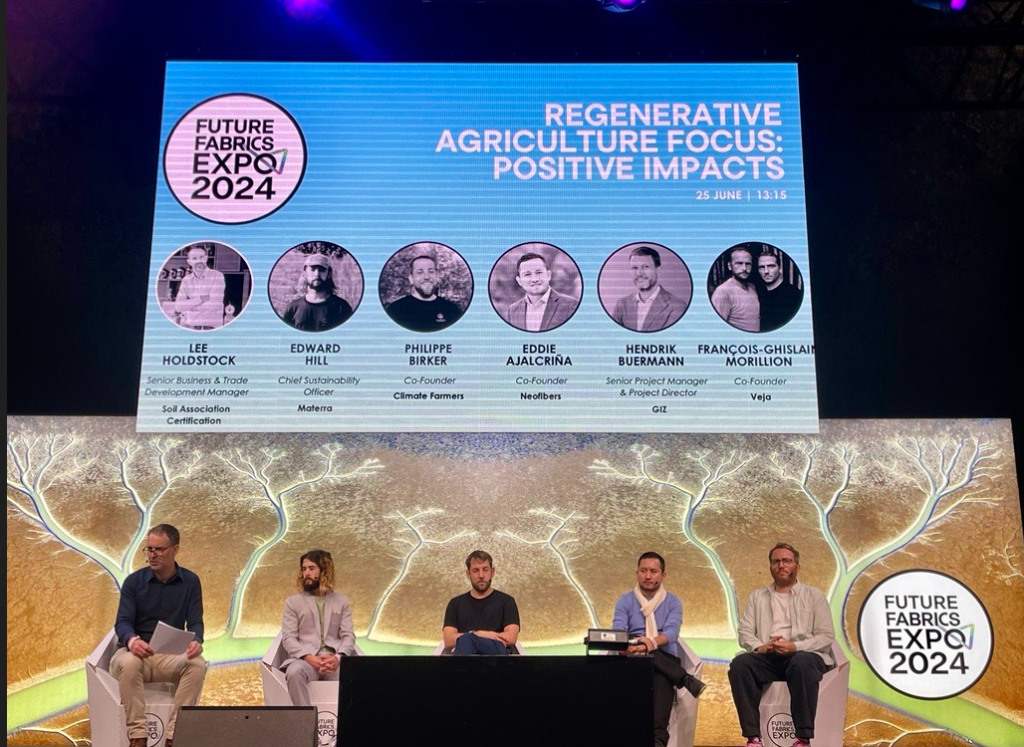The beginning of 2024 has seen many regenerative agriculture initiatives come to life such as Denim manufacturer Soorty’s attempts in Pakistan, CottonConnect’s pilot scheme in India and textile manufacturer Ventile’s efforts in Egypt.
In an interview with Just Style, Farheen Sayam, the manager of value chain engagement for the non-profit WWF Pakistan, even described her company’s regenerative agriculture project in Pakistan as a "ray of hope."
At the Future Fabrics Expo London 2024, industry leaders gathered to discuss how regenerative agriculture represents a promising approach to tackling climate change, improving soil health, and supporting biodiversity while providing sustainable livelihoods for farmers in the fashion and textile industries.
Philippe Birker the co-founder of Climate Farmers which supports regenerative farmers in Western Europe, set the tone by addressing the core issue: "Our current agricultural system is broken," he said.
According to a report by research firm McKinsey & Company, nearly one-third (27%) of greenhouse gas (GHG) emissions globally are estimated to come directly from agriculture.
Birker explained that farmers are often reduced to producing a single crop and maximising yield at the expense of ecosystem health, “hence the mess.” Regenerative agriculture, he argued, seeks to enable farmers to better understand and work with their local ecosystems.
Scaling regenerative agriculture
Regenerative practices must be adapted to local conditions, agreed the panel who all emphasised the importance of understanding world contexts when implementing regenerative agriculture.
Hendrick Buermann is the project director of the Regenerative Production Landscape Collaborative (RPLC) in Tanzania by Deutsche Gesellschaft für Internationale Zusammenarbeit (GIZ), a German development agency.
Buermann brought a broader perspective to the discussion by highlighting the work of the RPLC which began in 2023, with over 60,000 smallholder farmers in organic cotton production in Tanzania, making the region the largest producer of organic cotton in Africa and the fifth largest globally.
At the time of its launch, Buermann emphasised the need for a holistic, place-based approach that transcended the conventional farm-level and single-commodity focus.
The overarching goal was to help smallholder farmers adopt regenerative agriculture practices, participate in inclusive business models, conserve biodiversity, and enhance resilience to climate change.
Co-founder and impact director of Neofibers Eddie Ajalcriña, echoed this sentiment and brought a unique perspective from his company which develops textile products for sustainable luxury fashion sourced from the Peruvian Amazon.
Ajalcriña revealed that many Indigenous communities have been practising regenerative agriculture for generations, “They have been preserving the ecosystem and living in harmony with nature,” he said.
Their methods, he suggested, offer valuable insights for the industry. Ajalcriña identified frameworks like the Textile Exchange which published a report in 2022 to help the fashion industry understand regenerative agriculture. He went on to explain how the industry should attempt to incorporate new standards. Two types of fibres — cotton and exotic fibres — were highlighted by him, along with the high potential of Amazonian trees for fashion.
Buermann jumped in to stress the need to view farming as part of a wider landscape, both geographically and economically and introduced the concept of a "regenerative landscape" where all stakeholders work towards a common vision of agricultural production.
Organic vs regenerative agriculture: enhancing sustainability
While organic farming has paved the way, regenerative agriculture takes sustainability a step further. Regenerative agriculture is not just about environmental sustainability but also about social and economic impacts.
Buermann noted that organic certification primarily focuses on the absence of chemical pesticides, fertilisers, and GMOs, whilst regenerative practices aim to actively restore and improve the environment.
As regenerative agriculture gains popularity, various certification schemes are emerging. However, these can be challenging to implement, especially for small-scale farmers. The panel discussed the need for certification processes that are accessible and relevant to different contexts, particularly in developing countries.
Francois-Ghislain Morillion, co-founder of sustainable sneaker brand Veja explained how certifications are key to building trust with the brand, certification bodies and farming communities, “farmers need to feel engaged in the process to transition to regenerative farming,” he said.
Edward Hill the co-founder and chief sustainability officer (CSO) of fashion tech company Materra which specialises in regenerative cotton, linked this to the importance of maintaining human and emotional connections throughout the supply chain.
He also deemed engaging farmers with the end products and keeping them informed about their impact on the value chain as crucial to the success of regenerative initiatives.
Creating market demand
Hill went on to highlight the vital role of data and verification in the transition to regenerative agriculture. "Data collection and third-party accreditation are essential in verifying regenerative practices," Hill stated. This data, he explained, can help articulate farmers' narratives, and provide bespoke support to address specific issues.
Imran Asghar the managing director of South Asia and co-founder of Sourcery described the initiative as a way of creating “for-profit social enterprises” that build, “commercial value so that farmers can sustain themselves through their agriculture.”
Sourcery explained that it wanted to: “Establish a regenerative cotton programme in Pakistan that would support growers in rebuilding and sustaining their livelihoods in this climate-changing world.”
While regenerative agriculture offers environmental benefits, it must also make economic sense for farmers. Morillion emphasised that farmers need to be well-paid to transition to regenerative practices and shared that many won’t make the change until they see compensation for their efforts.
Birker believed there should be financial incentives for farmers to enhance biodiversity, moving beyond mere discussions to actual compensation. By suggesting that carbon credits could be a viable tool to address this issue, he said, farmers could earn almost EUR50 per hectare for sequestering 1-2 tonnes of carbon.
As the discussion concluded, one thing became clear: there's no “one-size-fits-all” solution in regenerative agriculture. The successful implementation of regenerative practices will require a holistic approach that considers ecological, economic, and social factors.









